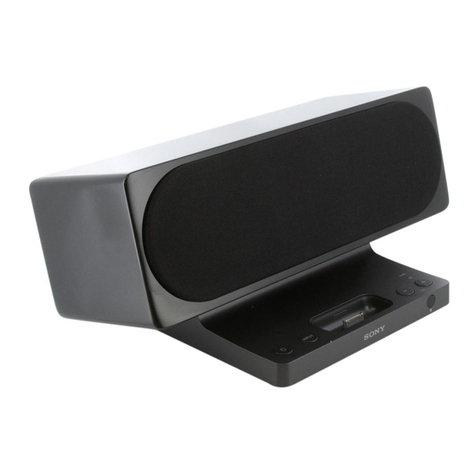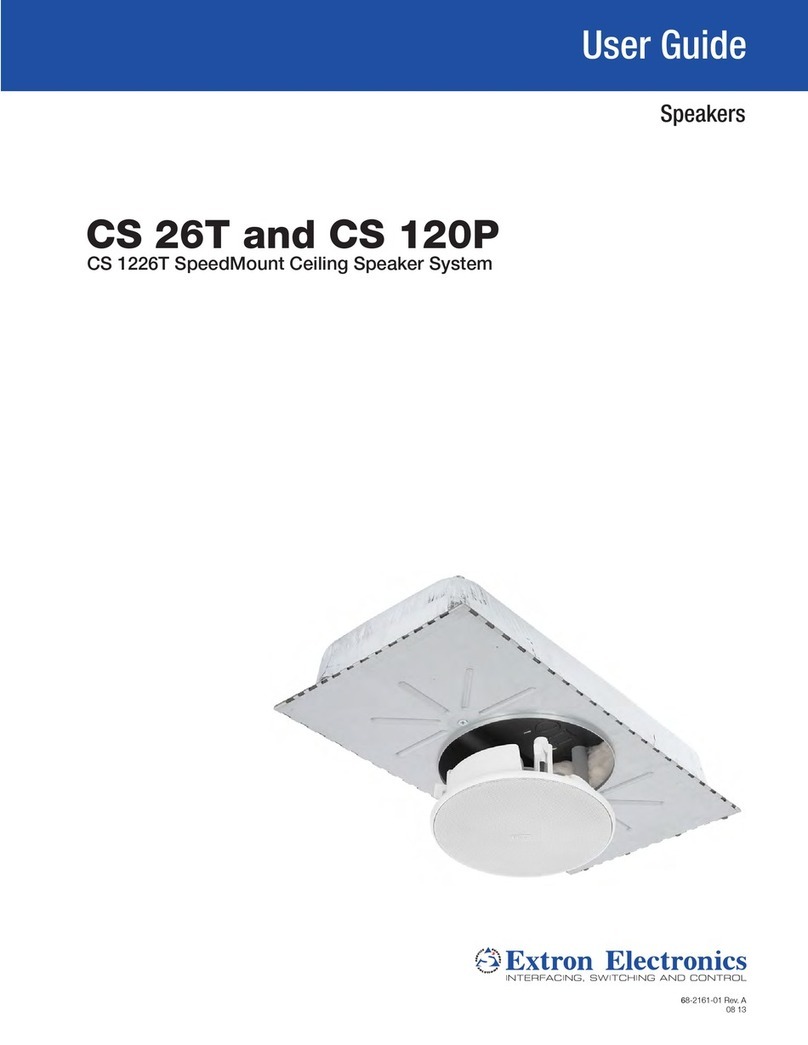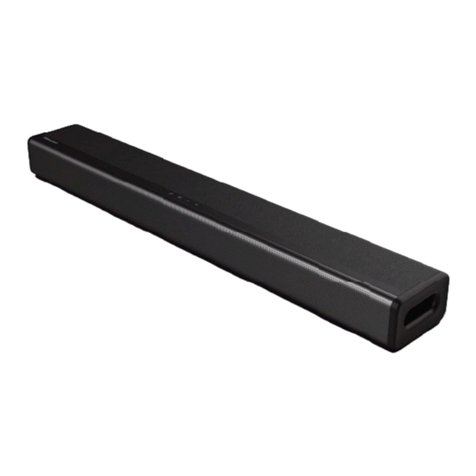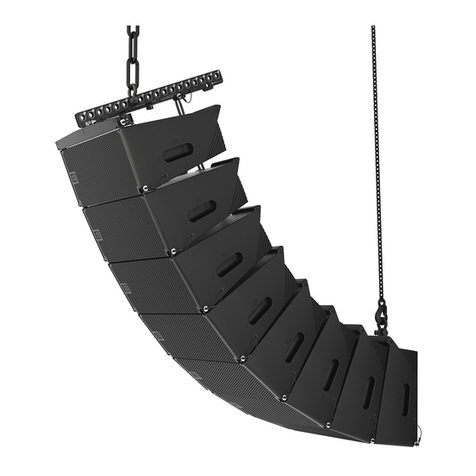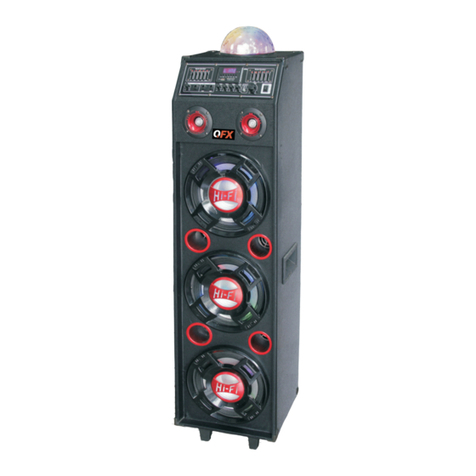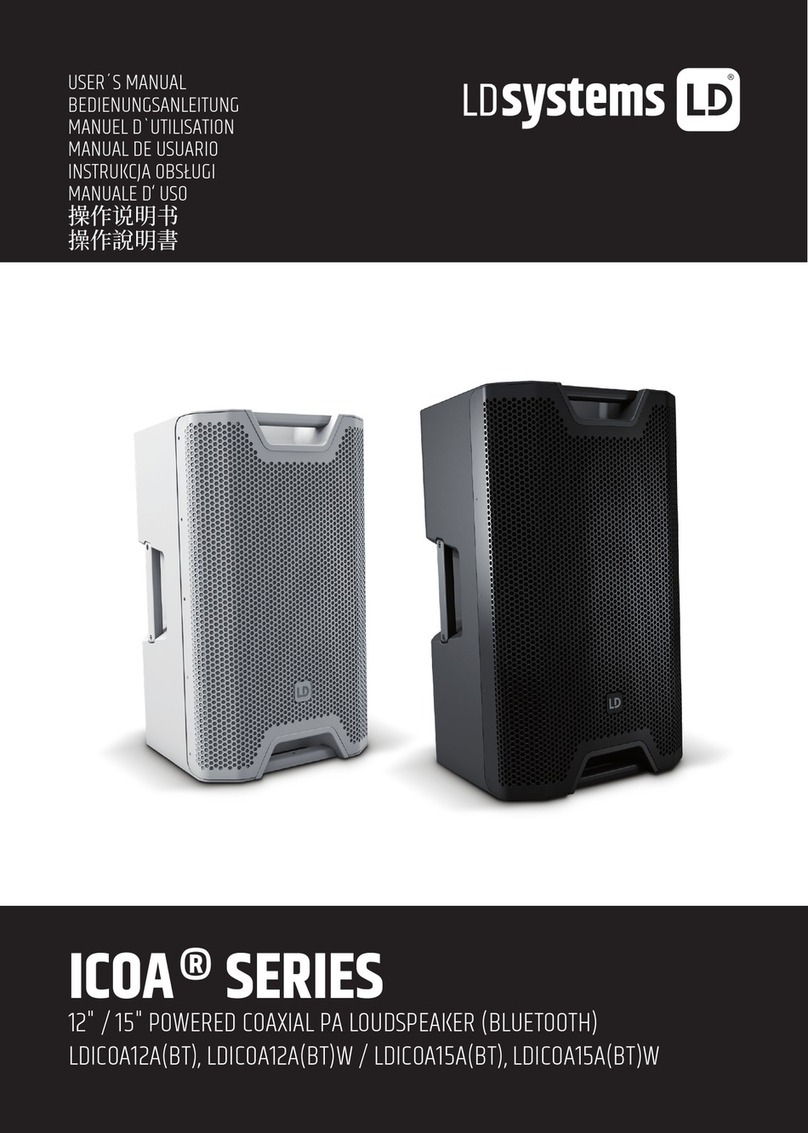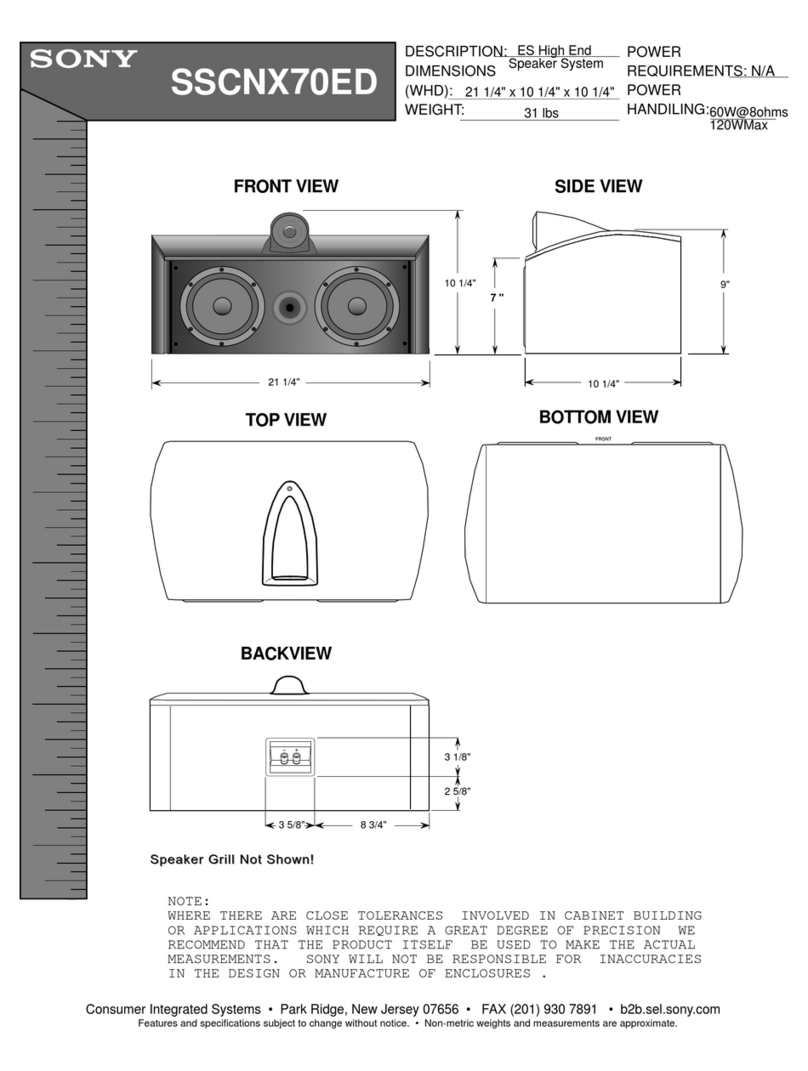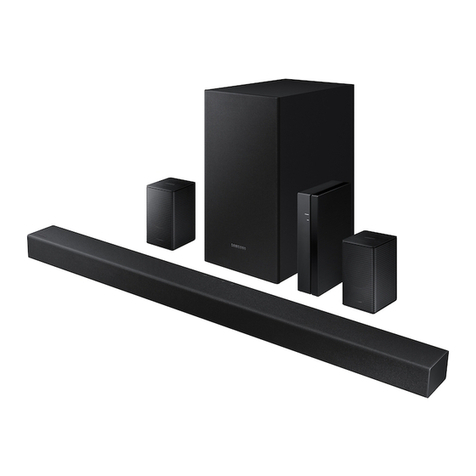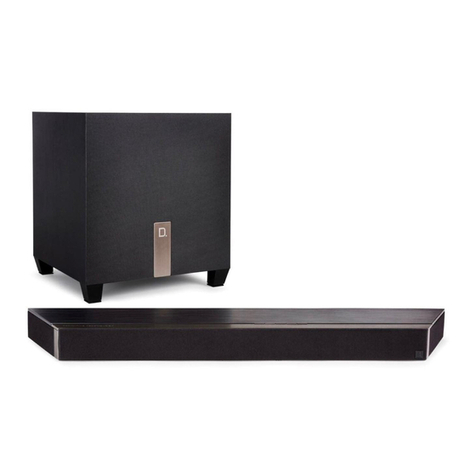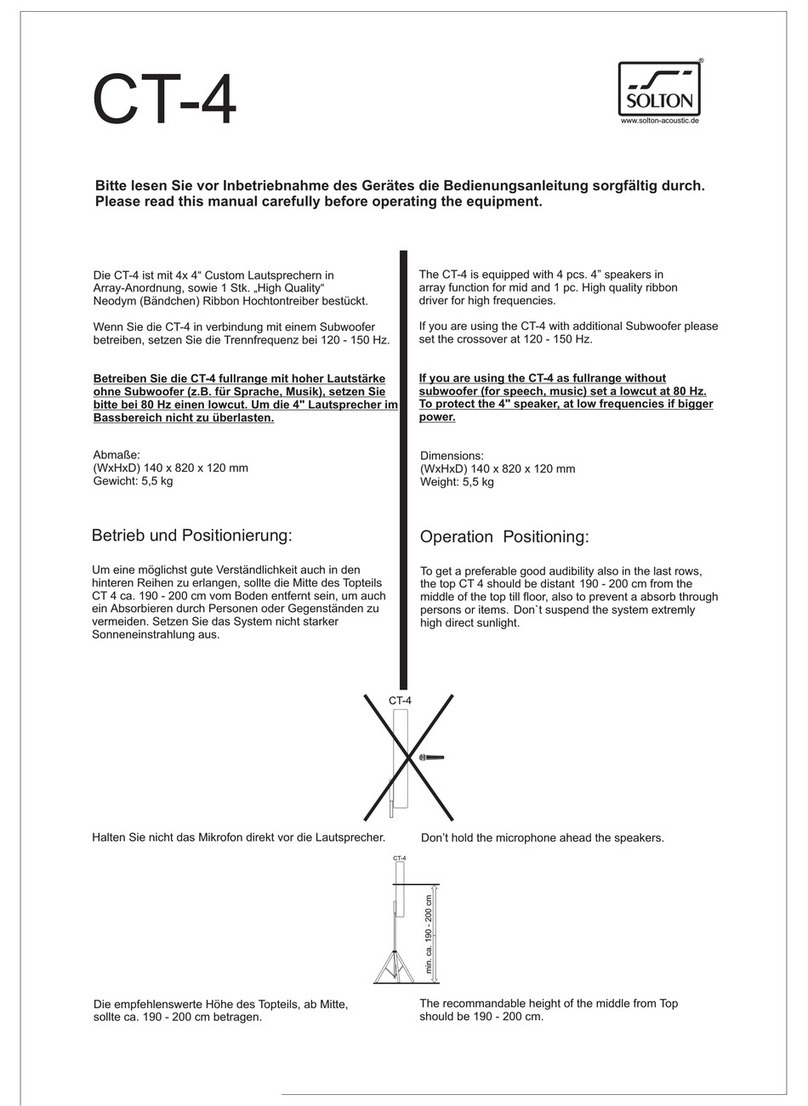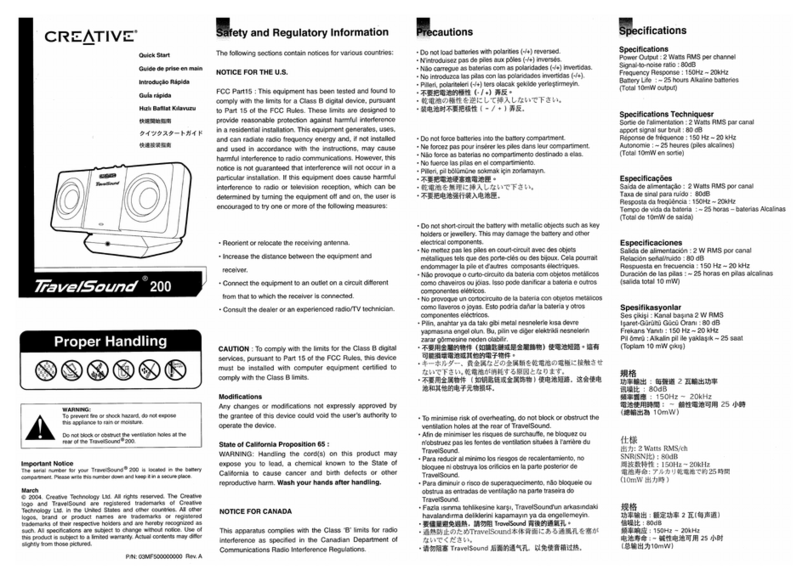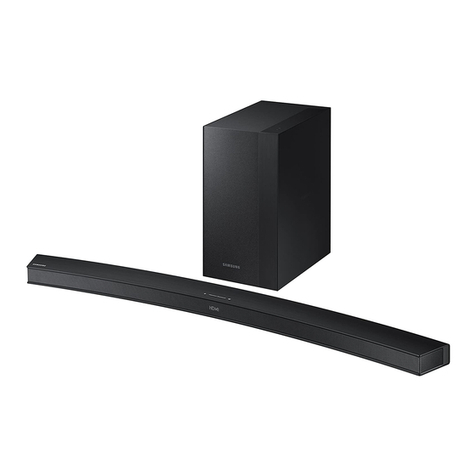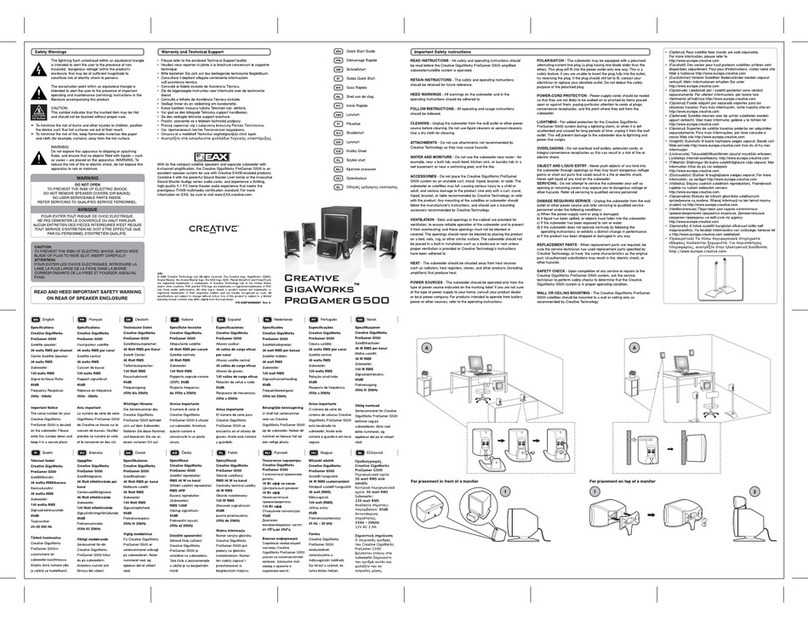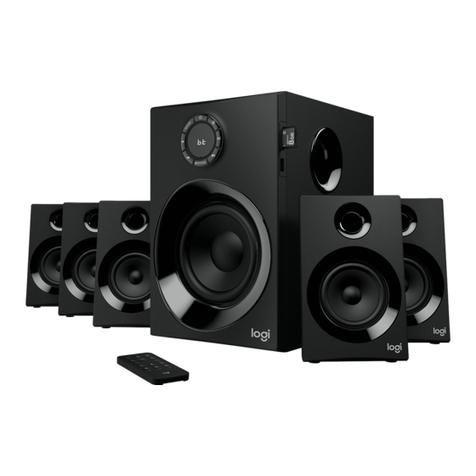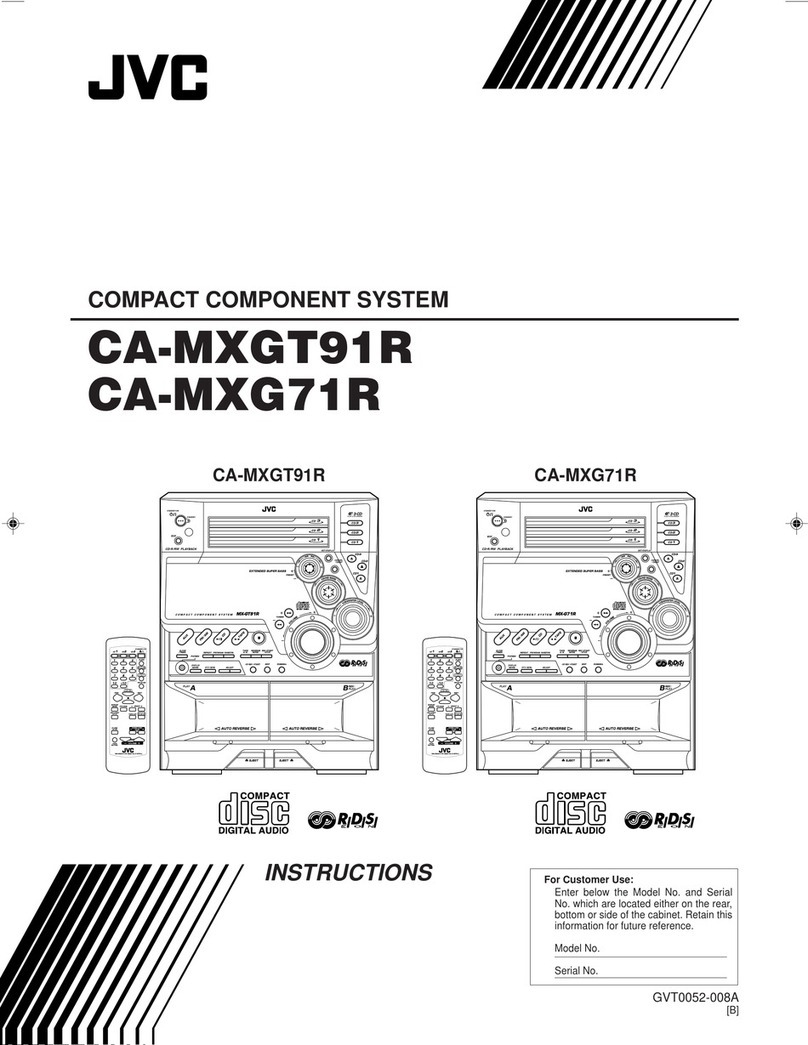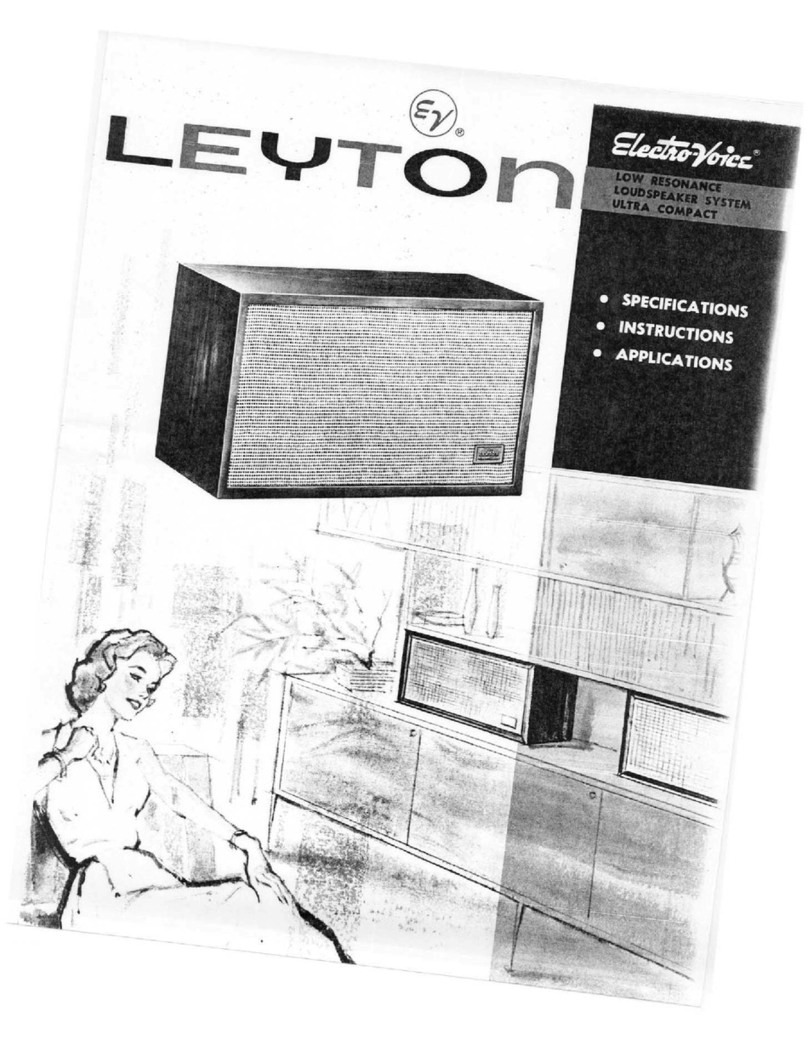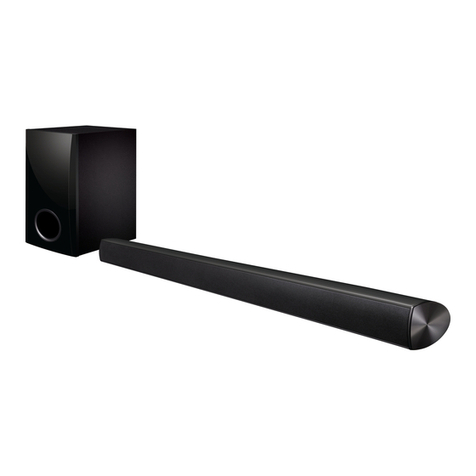Acoustat ONE Assembly instructions

MODEL,
ONE
ODEL
THREE
MODEL
ONE
+
ONE
MODEL
TW
MK
121
&
MK
141
VERSIONS
A
USTAT
Electrostatic
r
Systems
OWNER’S
MANUAL
AND
ASSEMBLY
INSTRUCTIONS

TABLE
OF
CONTENTS
Specifications
........................................................................
1
Limited
Warranty Statement
............................................................
1
Introduction
..........................................................................
2
Registration Cards
..........................................................
.........
2
Packaging
...........................................................................
2
Fusing
...............................................................................
2
Assembly Instructions
..............................................................
3
-
4
Sub
-
woofer Connectionsand Aacemenf
............................................
4- 5
Recommended
Set-up
and speakerPlacement
Distancefrom Wall
...............................................................
5
PlacementWithin the Room
.......................................................
5
Angling
.......................................................................
5 - 6
Acoustical
Properties
of the
Walls
..................................................
6
Phasing
.........................................................................
6
Electric Feedback
................................................................
6
Cleaning
.............................................................................
7
Removal
of
Interface
for
all
Models
....................................................
7
High Frequency
Balance
..............................................................
7
Schematic
.
MK
-
421
.................................................................
8
Parts
List
-
MK
-
124
...................................................................
9
Schematic
-
MK-141
................................................................
10
Parts
List
-
MK
-
141
..................................................................
41

SPECIFICATIONS
MODEL
ON€
-
FrequencyResoonse:30
-
1
8kHz
+/-3dB;SoundPressureLevel: 108dBmeasured
@
15'
in a 14’
x
18'
room. (music Peaks); Minimum
Power
Requirements:
75
Watts/Channel;
NominalImpedance:4ohms; PowerConsumption: 5Watts (120V,
50/60
Hz);
Dimensions:
72" x
11
"x
31/2";Bass ModelDimensions:
181/2"
x
18 1/2" x
4
81/2";
Weight:
65
Lbs.(Speaker andInterface).
37
Lbs (Bass Module)
MODEL
1
+
1
-
FrequencyResponse:35-20kHz+/-3dB;SoundPressureLevel:
108
db
@
18'
ina
14'
x
22
room. (Music Peaks); MinimumPower Requirements:
100
Watts/Channel; NominalImpe
-
dance:
4
Ohms;PowerConsumption:
5
watts
(120V,
50/60
Hz);
Dimensions: Model
4
x
x
3%”;Weight:
72
(Speaker andInterface)
MODEL
THREE
-
FrequencyResponse: SoundPressure
40
db@
ina
14
x
22
room. (Music Peaks); Minimum Power Requirements:
70
Nominal
Impedance:
4
Ohms;
Power
Consumption:
5
Watts
(
Dimensions:
28
x
Weight 98
MODEL
2
2
-
FrequencyResponse: SoundPressure
db
22‘
ina
x
26‘
room. (Music Peaks); Minimurn Power Requirements:
Nominal
Impe
-
dance:
4
Ohms; Power Consumption:
5
Watts
Hz);
Dimensions: 94
x
20”
x
95
Acoustat
specified
and
inservice,
defective
parts,subject to conditions
The
must or damaged abuse, negligence,
at
by
maintenanceare coveredby
OR
PRODUCT.
or

INTRODUCTION
Congratulations on your purchase
of
ACOUSTAT
ELECTROSTATIC
LOUDSPEAKER
SYSTEM.
Pleasereviewthe entire owner's beforeuoubegintoassembleyour new speakers
to
assure
you
of
reachingthespeaker'sfull potential.When assembled, placed in
the
room,
and used
with
fhe
proper
electronics,the electrostatic loudspeakers
youwith
years
of
listeningenjoyment.
REGISTRATIONCARDS
complete and return enclosed purchase registration card within ten
days
of
purchasedyournewspeakem.
This
card
doesnot
allow
you
of
updafesandother productnews
that
would be
interest
to
owners.
Any
additional youprovide
aid incontinuing
to
bring
music
lovers
everywherethe
finest
audiocomponents today.
PACKAGING
SAVE
ALL
PACKAGING
Your electrostatic are finely
pieces
d
equipment,and
must
be
property whenever
is
necessary.
ONLY
the originalpackagingmaterialsmay
be
obtainedfrom
at
a
charge.
FUSES
All
ACOUSTAT
loudspeakersutilize
fuses Inthe audiosignalpath. This
is
locatedonthe
rear
paneldthe
base
of each replacing
only
those
of
and
can
be
used
or
the
may
becomeinvalid.
LOW
-
FREQUENCY TRANSFORMER
TAP
(FULL
RANGE MODELS ONLY)
Before
assembly, locate low tapterminal
(identified
by
a
tag) and
that
setting
is
correctfor
modelas
per
below:
MI
M3
Red
Wire toRed Lug
Red
to
OrangeLug
Red
to
Yellow
Lug
This determines
bass
for
the
different speaker models.
setfing
in
bass
responsethat
is
weaker
thannormal.
2

3

ASSEMBLY
INSTRUCTIONS
ALL MODELS
PLEASE READ
COMPLETELY
BEFORE
YOU
ASSEMBLY.
For
assembly you
will
require a targe Phillips
type
screwdriver, and the small
attached
to
the interface cord.
2.
3.
4.
5.
5.
7.
Removebases,speakerpanelsandinterface fromtheirpackingcartons.To
the
of
the panels
for
assembly.
Using the small hex wrench provided, the disassemblethe side plates from the main
assembly.Set the screws andwrench aside they
required
later.
Set aspeaker base onthe
floor.
nameplate
side
up. the side plates
on
the baseas
shown
(1
securingthem
two
slot
head
screws
per
plate.
Leave
Lay
speaker
GENTLY
onthe
floor,
thewiringharnessfacing
up.
DO
NOT
DROP!
The frapped
air
underfhe panelcanrupturefhespeakerdiaphragm.
Have
ahelper
raise
the
lower
end panel,
or
support
it
onthe box.
thecompletedbaseassembly shown
aligning
the side plates
to
the inthe speaker backpanel.Tighten allscrews securely.
Standing
the
compfetedspeaker upvertically.positiontheinterfaceassembly the
speakerasshown
(3).
Locate harnessemergingfromthe the
speakerpanel.Separatethethreewire bundles
into
the
withthe plugonthe
end: the
BLUE
group
With
the blue hook
on
end;andthe
WHITE
gmup,
with
onthe end.
Referring
to
diagram
insert pinplug
(RED
group) intothe
RED
socketon circuit
board
of
theinterface
Aff
ach
BLUE
hook
to
the ontheright
side
the
blue
dot
the spacer
below
the thumbscrew, andthe word
'BLUE'.
the
thumbscrewseveral
washerandtighten
Repeaf
this procedure
for
the
hook on fhe
side
of
the circuitboard.
assemblethe inferface
side
plates,
GENTLY
feedingthe
wiring
back thehole
in
thespeakerpanel. onthe side
plates.keeping flanges onthe
OUTSIDE
side
as
shown
(4)
&
(5).
the
four headscrews infofhe hofesinthesides inferface.andttghfen
the
hexwrench provided
(5).
9.
Position
fhe assembledspeaker systems
the
room,
two
or
three
from the
backwallandat
least
'SPEAKER
section
of
the
the cord
info
an wall
outlet. speaker terminals to making sure that proper phasing
positive
(RED)
terminal
on
speaker
is
connected
to
(RED)
terminal
on and
for
(BLACK)).
1411
B
INTERFACE
SYSTEM
GENTLY
layfhewoofermoduleon
its
side,
exposingthewoofer coneand
left
andrightterminal
connections
(6).
Connectthewoofer onthe the terminals labeled'woofer'on
the back
of
the
speaker inferface.Repeatthis procedure
for
the right
Be
sure
properphasing
(see
section
on
phasing
in
the placement
section
of
the manual.)
4

FAX
704 331 0402 LEE NICHOLS ARCH
When complete,there
be
a
and
a
rightcable tothesinglebass module.Return
bass
module
its
operating (wooferconefacingdown).
While
is
generally advisableto placethe bass module
a central location
speakers,someroomarrangementsmaynot
permit
this.Our listeningtestsrevealedbalanced
bass
performancewhen the modulewas placed the shadedarea in
“PLACEMENT
DIAGRAM”.
proximity
to
walls
corners
result in uneven response, with these
placements yieldingincreasedbass atthe expense
of
NOTE
thebreak
-
in electrostaticportion
few days
of
time
producesonic improvementandan increaseinefficiency.
RECOMMENDED SET
-
UP AND SPEAKER PLACEMENT
DISTANCE
FROM
WALL
Leave
at least
three
feef
from
to
the
rear
wall.
To
determine
this
distance,measure
fromf hecenterofthe
betakenon
a tothe speaker.
at
two
from
the side
of
thespeakers
to
theside
walls.
PLACEMENT
THE
ROOM
By
placing speakers far apart against a tong
you
wilt
obtain the largest “listening
window” without loss of center
All.
Racethe speakers
so
they
anequilateraltriangle
with the listeningposifionat
apex. (Refer
to
Figure
IA).
LOW
RESPONSE
the speakers against the short
of
the
room,
with
the rear
of
the speakers
projectinginto the
possiblebass
will
be
obtained.
maybeimpossibleto
retain
two
feet suggesteddistance
from
thestde
of
thespeakertot
he
wall
in
a
narrow
room.
In
this
case,
it
is
to
usethe spacetoseparatethe
andIocafe
to
the side (Refer
to
Figure
ANGLING
Anglethespeakerswiththepanelsdirectedtowardthelisteningposition.There are
two
general
“apex”
is
slightlyin
of
the
listener.(See Position
A).
This arrangement
the widest
listening
window.
you
to
moveyour listeningpositionwith
minimum change;
OR
Anglethe speakers
so
thatthe “apex”
is
slightlybehind listener.
(See
Position
This
5

arrangementreducesthe
"
Listeningwindow,
"
butprovidesa morefocusedsound.
requires
angling,therefore. speakersareangledoutwardslightly
to
achievethis
"
apex
"
position.
NOTE
Neitherposition
is
in cases other. Personaftasteandroomplacement
which
is
the best
for
you. Experiment!
ACOUSTICAL
PROPERTIES
OF
THE
WALLS
A
end
-
dead end sef
-
up in the listening room can sometimes improve the sonic
of
a
speaker This can
be
accomplishedbyusingmaterials
speakers such
as
fiberglass panels,carpet. etc. the walls can
more
preciseimagingandsuperiorfocus
from
your
speakers. alisteningtestbeforeyou
fhe walls usinga
heavy
blanketsuspended while
you
listen.
THE
SOLID LINES
ARE
SHOWN
TO
ANGLING ONLV WHEN THE PANELS
ARE
PER-
PENDICULAR TO THE
THAT
APEX
DASHED LINES REPRESENT
SONIC
RADIATION
OF
THE
SPEAKERS
SPEAKERS
SHOWN
ARE
DRAWN WITH
THE
FRONT
PLANE
OF
ME
PERPEN
-
DICULAR
TO
THE LISTENER IN
A
ROOM
THIS
WOULD MELD
THE
IN
THE
B
TO
ACHIEVE
THE APEX
IN
A
THE
SPEAKERS
WOULD
HAVE
TO
BE
ANGLED
INSLIGHTLY
I
I
I
I
speakersaredesigned
to
preservethecorrectabsolutephasethroughoufthesystem,
the coupling
the signal to the air. The ensures that both vocalists and
soundas naturalaspossible.Phasingdependson connecflonsh
-
om
(+)
black(
-
-
)
to
black.
ELECTRIC
FEEDBACK
Electrostaticspeakers produceastrongelectricReldwhichcan theoperation
of
any
low
level
electroniccircuitry
close
proximity.This can infeedbackwellabovethe audio
hasthe
of
powerdissipationanddecreasedheadroomin system.
For
this reason,the leadsandthe phonoinputs
of
the preamplifiershouldbe
keptat Least
six
to
eight
feef
from
the nearest
that nofeedback canoccur.
WARNING! DO
NOT
applyaudio
to
the intelface the
Power removed,hence
no
panelbias! Connection
to
switched
is
not
recommended.
DO
NOT
exceed
fuse
ratings
or bypass
receptacle. Either the above
in damage
low
frequency
if
the interface
is
requiringand
covered
bythe
6

CLEANING
Speakerclothmaybecteonedwithanycommercial oranycleanerdesignedfo
be
usedwith polyesterknit
Use
cleanersuchas
K2R
for
concenffatedspots.
interface
be
removed
from
the speaker, the following procedure
is
necessaryto
dischargethe panels:
2.
3.
4.
5.
6.
UNPLUG
interfacefrom the outlet and the
speaker
leads from the
amplifier.
Remove the four headscrews secure the main interfaceassembly, usingthe
provided.
the interfaceunit
from
side brackets
theinterfaceunit ontheBoordirectly behindthespeaker,beingcareful
not
tounpfug
the three
wire
groups
or
strainthe wiring harness.
Removethecenter
RED
pinplug.
Hold
thewireaninchbehindthepinand
pull.
DO
NOT
GRAB
PLUG!
Touch
to
eitherthe
BLUE
or
WHITE
on the circuit
Loosenthe
thumbscrews andremovethe hooks.
WARNING: High static are present
in
the charged panel.
to
fallow these
procedures
will
result
in
anannoyingbut shack.
-
FREQUENCY BALANCE
CONTROL
frequency balance
is
atthe
for
optimum
a
room
acoustics.
This
levelcan
be
adjustedfor situations
in
fhe followingmanner.
Follow
the for
“REMOVAL
OF
INTERFACE
at fhe end
of
manual.Referring
to
diagram
locatethe highfrequencybatanceresistorintheinterfaceassembty.Loosenthe
center tap and
or
right, according
to
the diagram for increase or decrease.
After
adjustment, tap
NOTE
optimumperformanceandstereoimagingbe
SURE
that
are
IDENTICALLY.
checkedwith an ohmmeter.

\
N
W
W
N
m
m

List
-
MK
-
121
c2
c3
c4,
220
3300
Polystyrene
Polypropylene
Non
-
polar
6
Polypropylene
6KV
R2.
R3
R4
‘TI
T2
F2,
F3
6
ohm
slider
50
ohm
w
ohm
20
w
500
M
ohm
2W
High
diode
Transformer
Hi
Frequency
Acousfaf
21
Lo
Frequency Transformer
5
Amp
Amp
9


FAX 704 331 0402 LEE NICHOLS ARCH
Component
Values
List
-
c2
40
c3
220
C5,
C6
220
C9,
CI
0,
3300
R5
F2,
F3
UF
6
ohm
50
w
slider
K
ohm
ohm
3w
500
M
2w
5
ohm
20
w
2561
High
diode
45
ohm
Air
core indicator
Bias
Transformer
6
Ceramicdisc
Non
-
polar
3
Ceramic
disc

Terrace
Fort
33315
phone:
This manual suits for next models
3
Table of contents
Other Acoustat Speakers System manuals


